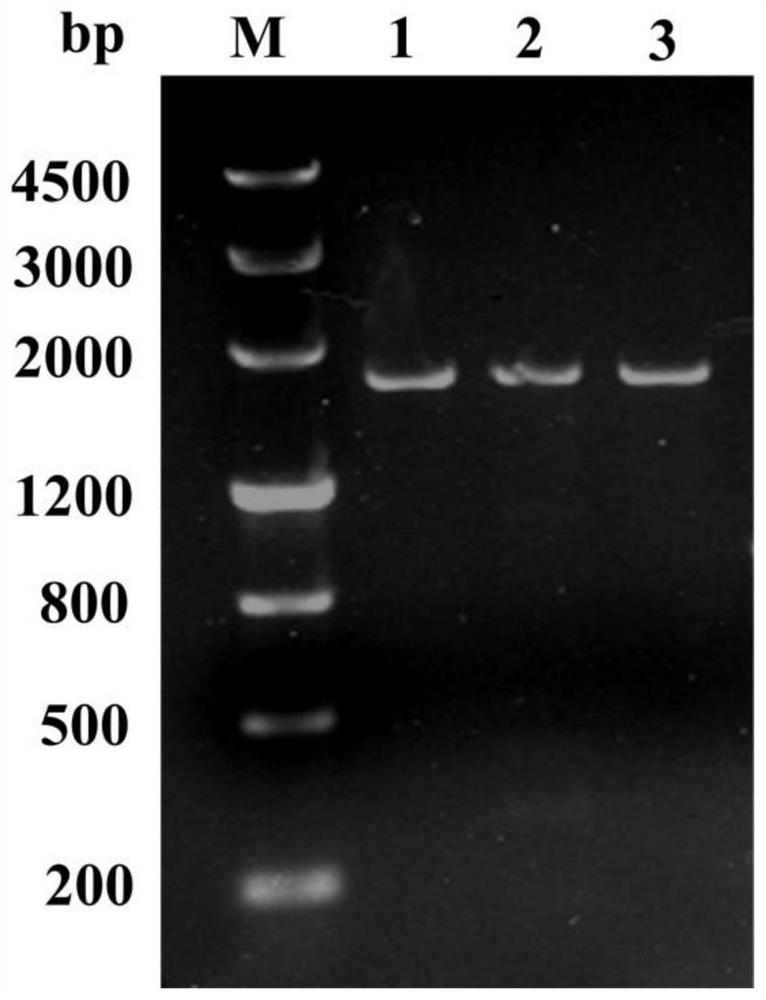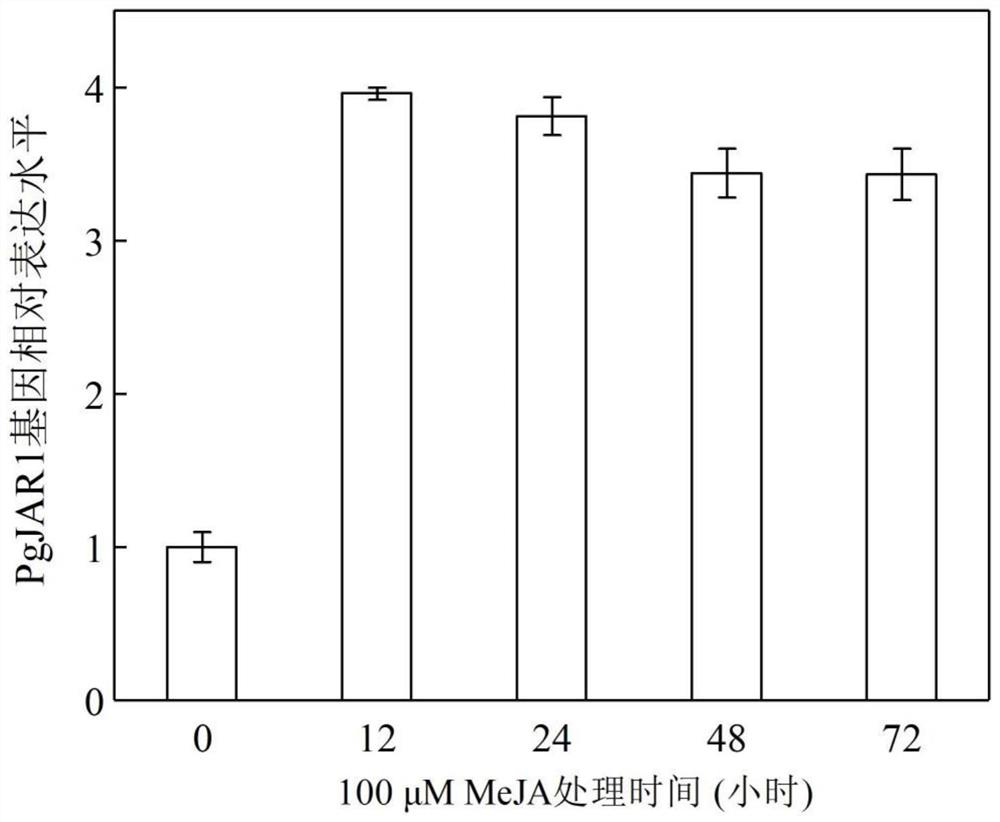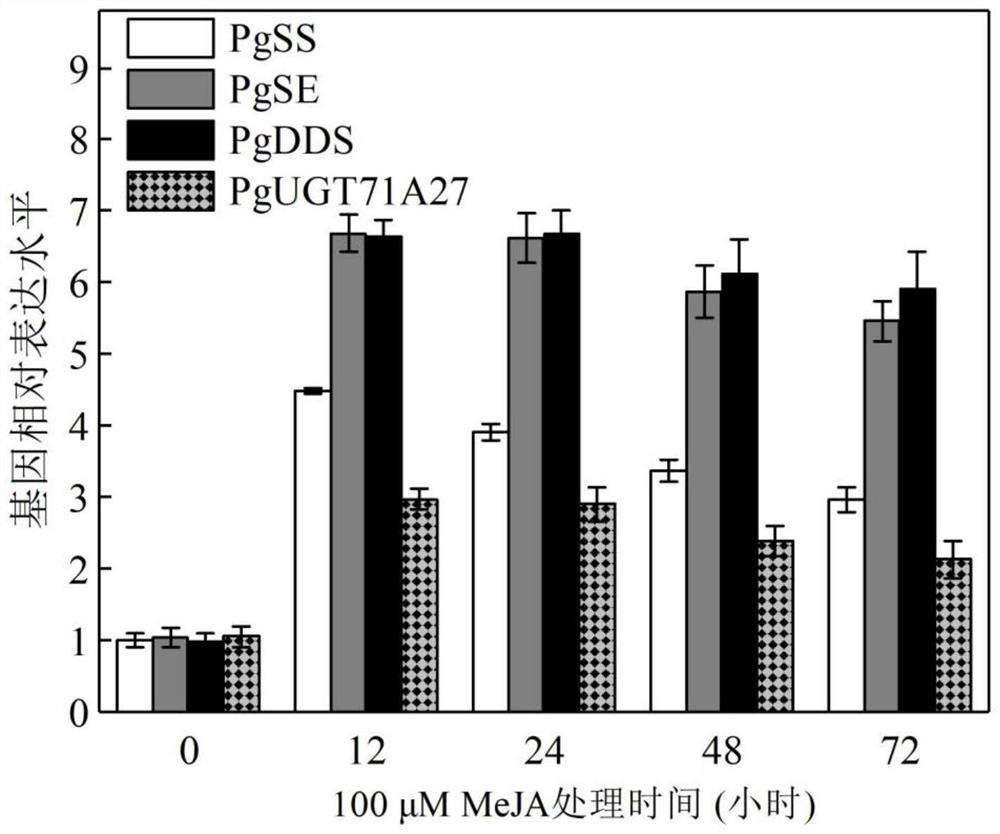Ginsenoside synthesis-regulated PgJAR1 gene as well as encoding protein and application thereof
A technology of ginsenoside and gene coding, which is applied in the fields of application, genetic engineering, DNA/RNA fragments, etc., can solve the problems of unreported research and achieve the effect of high yield, specificity and practicality
- Summary
- Abstract
- Description
- Claims
- Application Information
AI Technical Summary
Problems solved by technology
Method used
Image
Examples
Embodiment 1
[0036] Acquisition of the PgJAR1 gene
[0037] 1. Ginseng RNA extraction and reverse transcription to prepare cDNA
[0038] The hairy roots induced by fresh 4-year-old ginseng roots were cultured in 1 / 2MS liquid medium at 120rpm and 25°C for 3 weeks in the dark, then 100μmol / L MeJA was added to the medium, at 25°C, and the dark culture was continued for 24h. The roots of ginseng are placed in a mortar pre-cooled with liquid nitrogen, and quickly ground into fine powder after adding liquid nitrogen. Take 30-40mg into a 1.5mL centrifuge tube, add 1mL TRIzol reagent, 40μL β-mercaptoethanol, mix well and place at room temperature for 5-10min; add 0.2mL chloroform, shake for 15s, and place at room temperature for 10-15min; 4°C, 12000 Centrifuge at ×g for 15 min, collect the upper layer and place it in a 1.5 mL centrifuge tube, discard the precipitate; add 0.4 mL of 3mol / L ammonium acetate (pH5.2) and 0.6 mL of isopropanol, mix well, and place at room temperature for 5-10 min, 4 C...
Embodiment 2
[0048] Fluorescent quantitative PCR (qRT-PCR) analysis of the expression levels of PgJAR1 and ginsenoside biosynthetic enzyme genes
[0049] 1. RNA extraction and reverse transcription
[0050] The RNA of hairy roots induced by 4-year-old fresh ginseng roots was extracted, and the hairy roots were cultured in 1 / 2MS liquid medium at 25°C and 110r / min in the dark for 21d, and then added MeJA (100μmol / L) for treatment. Take out the hairy roots for RNA extraction, and the extraction method is the same as in Example 1. The above RNA uses oligod (T)18 as a primer to synthesize cDNA with a pseudo-transcriptase. Primers for qRT-PCR analysis of β-actin, PgJAR1, PgSS, PgSE, PgDDS and PgUGT71A27 genes are as follows:
[0051] β-actin fluorescence quantitative primer F: 5'-TGCCCCAGAAGAGCACCCTGT-3'; (SEQ ID NO.5)
[0052] β-actin fluorescence quantitative primer R: 5'-AGCATACAGGGAAAGATCGGCTTGA-3'; (SEQ ID NO.6)
[0053] PgJAR1 fluorescent quantitative primer F: 5'-GCGGACCTACCGCTATTGAG-...
Embodiment 3
[0068] Extraction and content determination of JA-Ile in ginseng cells
[0069] 1. Extraction of Ginseng JA-Ile
[0070] Take fresh ginseng callus or hair root and grind it into dry powder in liquid nitrogen, weigh an appropriate amount, add isopropanol-water-hydrochloric acid mixed extract, add 8 μL 1 μg / mL internal standard solution, shake at 4 °C for 30 min; add Dichloromethane, shake at low temperature for 30min; centrifuge at 13000r / min at 4°C for 5min, remove the lower organic phase; dry the organic phase with nitrogen in the dark, redissolve with methanol (0.1% formic acid), centrifuge at 13000×g at 4°C for 10min, take The supernatant was passed through a 0.22 μm filter membrane, and JA-Ile was detected by HPLC-MS / MS.
[0071] 2. Determination of ginseng JA-Ile content
[0072] Liquid phase measurement conditions are: Agilent 1290 chromatograph, chromatographic column is Poroshell 120SB-C18 reverse phase chromatographic column (2.1×150, 2.7 μm); Column temperature: 30...
PUM
 Login to view more
Login to view more Abstract
Description
Claims
Application Information
 Login to view more
Login to view more - R&D Engineer
- R&D Manager
- IP Professional
- Industry Leading Data Capabilities
- Powerful AI technology
- Patent DNA Extraction
Browse by: Latest US Patents, China's latest patents, Technical Efficacy Thesaurus, Application Domain, Technology Topic.
© 2024 PatSnap. All rights reserved.Legal|Privacy policy|Modern Slavery Act Transparency Statement|Sitemap



